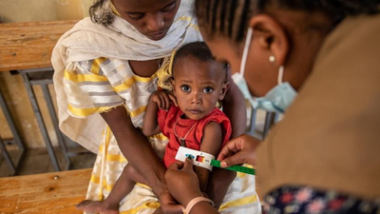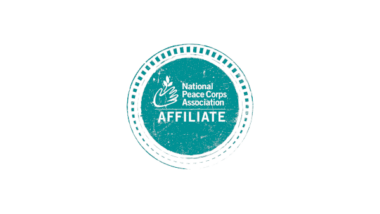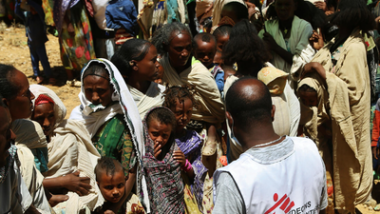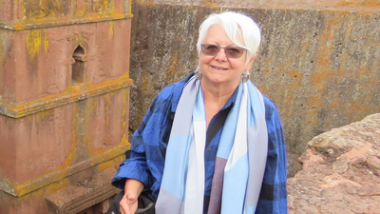 by John Coyne (Ethiopia 1962-64) originally published on Peace Corps Worldwide on August 4, 2020.
by John Coyne (Ethiopia 1962-64) originally published on Peace Corps Worldwide on August 4, 2020.
In the famous Mayflower Hotel meetings in early February 1961, Shriver’s Task Force established a Peace Corps with three goals. Today, 59 years later, former Volunteers have created a Fourth Goal. In many ways, this Goal is the most significant accomplishment of the Peace Corps. I think it is the greatest contribution made by RPCVs.
We all know the Peace Corps is not about Volunteers. It is about the people we came to know, the children we taught, the people we helped, the villages where we lived.
Returning home, we didn’t forget those lessons, friendships, or our connection to their country. More than a few Peace Corps Volunteers look back, go back, and give back to friends they left behind. It is estimated that since 1962 when the first Ethiopian Volunteers arrived in-country, as must as ten million dollars has been spent by these RPCVs on their host country families and friends, everything from supporting students to study in the United States, building libraries, schools, and medical facilities, creating foundations, as well as, writing, teaching, and promoting the Land of the Queen of Sheba as an unforgettable tourist destination.
Here are the stories of what three RPCVs, and one staff member, have done for Ethiopia since their tours of service. Their stories, I am sure, can be told by former PCVs from all the Peace Corps nations. Soon, I hope, all of these acts of kindness and appreciation will be recognized by the NPCA and by the Peace Corps agency.
Paper and Chrome
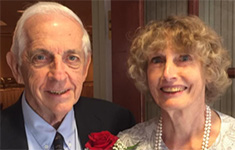
Bill and Betty Graff
When Betty and Bill Graff arrived in the village of Wolaita, Sodo in 1964 for their second year as teachers in Ethiopia, they found, as Bill described it, “A village with no running water, no electricity, no telephones, no grocery stores and no police department. And there was only one car in the town, owned by a businessman.”
It was a village of dirt roads, and grass-covered houses. The “mud” houses were owned by the “northerners” who conquered Wolaita 70 years before. These houses had tin roofs that identified them as being in the ‘upper class’.
The two Volunteers opened the first high school with nineteen students. Today this part of Ethiopia has more than 70 high schools, with more than 3,000 students in each school. Returning to his “village”, Bill says, “has been an inspiration to watch this happen and to play a small part in its large growth.”
In the late 1990s, Betty and Bill Graff began to look for ways that they could help their Peace Corps village and decided on getting books for a local Wolaita Sodo school library. The town built the school; the government provided the teachers, but there were no textbooks and no books in the library.
The Graffs concentrated on getting books for the school library. The project grew, and through their efforts, they obtained about 300,000 books that were divided among all the high schools in the SNNPR region. They were supported by the regional governor, Haile Mariam, who had been a student at their school when they were PCV’s. He later became the Prime Minister of Ethiopia.
With the books in place, and when Betty and Bill arrived in Wolaita, Sodo quickly saw that the books did not directly help with the school-leaving exam which is what the students focused on.
They decided they could spend their money and efforts better by refocusing their attention on other aspects of the school.
They established a set of rules for the schools, setting up these restrictions.
- A committee of parents and students selected the list of books to be bought in Ethiopia; the list had to be approved by the principal.
- The library had to be open extended hours and six days a week.
- The books had to be available for overnight borrowing by students.
“We funded about a half dozen schools under this arrangement,” Bill reports. “The project had excellent success and were so well used that the books were in tatters within two years.”
By that time, the government was providing textbooks and a limited number of library books, so Bill, mainly because of his computer career in the United States, decided to try ebooks. “This was right down my alley. I could finally use my technical background to help the good people of Wolaita.”
The Graffs hired a part-time programmer in the United States to build a server that would hold open-source educational software like Khan Academy and all the Ethiopian curriculum and videos. They then installed a server and 30 Chromebooks at the lab school in Wolaita, Sodo as a pilot project. The students loved them. As a bonus: When electricity shut down continuously during the day, the students could still use the laptops. Based on that success, the Graffs installed this same learning lab in three more high schools in Wolaita, Sodo.
At this point, they became aware of RACHEL, which stands for Remote Area Community Hotspots for Education and Learning. It is a portable plug-and-play server that stores educational websites. To save on development and technical costs, the Graffs switched to RACHEL for all of their future installations. They installed seven systems over the next two years in other parts of Wolaita.
When they visited the installed learning labs recently, they met student proctors who were sleeping in the labs so that they could get more time using the lab. The learning labs were well used all day and sometimes all night. Because of the number of students, the schools run split sessions: When the morning students are in school, the afternoon students use the learning lab—and vice versa. Their number one request: “More Chromebooks.”
As the Graffs proceeded to work with the school libraries and learning labs, they also observed other severe needs of the schools involved. Depending on the school, they supported girl students, paid for desks, or built latrines. With the help of another RPCV from their group, John Kulczycki, a retired professor of history from the University of Chicago, they installed a large generator at the lab school.
They also worked with another RPCV, Janet Lee, who was working in Tigre province. They put a learning lab in a library in Axum that Janet was instrumental in setting up and supporting. The fellow members of their Peace Corps group contributed money at one of their RPCV reunions and were instrumental in funding this installation.
Betty and Bill also helped World Possible, the developer of RACHEL, in Tanzania. The Graffs’ non-profit ET-Learns funded a BYU student to make an installation in Tanzania. Their foundation also funded five learning labs in Tanzania where a Peace Corps Volunteer was assigned.
Storytime
Janet Lee, who was from a small town in Colorado, who had never been out of the country, and only flown on a plane once in her life, flew to Ethiopia in 1974, to serve as a Peace Corps Volunteer and an English teacher in southern Ethiopia. She was assigned to a new modern World Bank secondary school with electrical fixtures, but no electricity, and flush toilets with no water. However, a classroom had been converted into a small library funded by the Gurage Road Association and because she had worked in libraries since the age of 14, she took it on as one of her projects. That was a rarity in Ethiopia, a librarian.
She has returned to Ethiopia many times since, once to work with Project Mercy in the Gurage Zone. The next time to set up a school library in memory of a Regis University colleague, and later to set up a children’s library in Mekelle, the capital of Tigray Province in northern Ethiopia, close to the border of Eritrea, during a five-month sabbatical in 2010.
Having been a librarian at Regis University in Denver, Colorado, she was able to take these opportunities to meld her profession and her passion into one: libraries and literacy in Ethiopia. “Each time I returned to Ethiopia,” she says today, “I knew I was returning home.”
For Janet, returning to Ethiopia, has a sense of familiarity, “like comfort food,” she says. “Hearing the language spoken, the slower pace, scents of spices, perpetual greetings, flashing smiles, and children laughing, gives me a sense of belonging.”

Janet with her students
Through word of mouth and the internet, noted author and storyteller Anne Pellowski, a former librarian and storyteller at the New York Public Library, who has consulted for UNESCO, UNICEF, and World Council of Churches and author of The Storytelling Handbook and How to Make Cloth Books for Children, a step-by-step guide to creating books in local languages, approached Janet about conducting children’s book publishing workshops in Ethiopia. Janet joined with Anne to set up workshops in Addis Ababa and in Mekelle in 2013.
Janet’s most recent trip back “home” was in August 2017. She received a Fulbright fellowship and was assigned to her top choice, Aksum University. “The only other American in Axum was a PCV teacher who had extended for a third year. “He, like me, chose to live within the community and not be part of a large ex-pat circle isolated from the day-to-day life of the country.”
For ten months, she split her time between the university and the Axumite Heritage Foundation Library, one almost being the extension of the other. She investigated open access journals, set up a computer lab, cataloged books, advised on library operations and collections, was part of a team that saw the grounds of the Foundation Library transform, and provided workshops in other parts of Ethiopia on children’s book publishing in local languages.
She also contracted to have a book about the battle of Adwa translated into Tigrigna. And she and a colleague published a book with the African Storybook project about a female bajaj driver that has been published in four Ethiopian languages.
All of this she did within ten months. “It might seem like a long time,” says Janet today, who is back in Denver where she had been the Dean of the Library at Regis University and is currently Dean Emerita. “But leaving Ethiopia was one of the hardest things I have ever done. What do you do when you have fallen in love? …with a country? ….with a people? I may have returned home to Colorado, but I have left home as well.”
The Essential Guide to Tigrinya
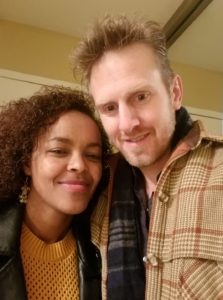
Haimanot & Andrew
When Andrew Tadross (Ethiopia 2011-13) arrived in-country his first challenge, as it is for all Volunteers, was learning the language. Getting to know Amharic and Tigrinya was not easy. They are complex Semitic languages, with unique sentence structure, a multitude of conjugative rules, and their own alphabet. He found he was limited to short phrases and butchered sentences, despite having a solid vocabulary.
Andrew would spend his first year in the small village of Endodo in southern Tigray. In his second year, he moved north to Mekele, where he taught landscape architecture at the university.
The idea of writing a Tigrinya reference book began to coalesce and took root when he met Abraham Teklu, a hotel owner in Mekele, who had published an out-of-print dictionary some years previous. Together they decided to draft a new book that included grammar rules as well as vocabulary, and which featured phonetic transliteration. It was called The Essential Guide to Tigrinya.
The book grew in its scope and scale, reaching 190 pages before it was published in 2015, two years after Tadross left Ethiopia. Once published, he was pleasantly surprised to observe that the book consistently sold about 30 copies a month. Seeing that it was a useful, marketable book, Abraham and Andrew set their efforts on publishing the next logical book, The Essential Guide to Amharic.
Amharic, the national language of Ethiopia, had a larger market. That book continues to sell about 35 to 50 copies per month. As Andrews recalls, “It has been encouraging to see positive reviews pop up on Amazon from people who have used the book as Peace Corps Volunteers, U.S. Embassy staff, USAID workers, missionaries, tourists, businessmen, members of the Ethiopian diaspora, and people who use it to communicate with loved ones from Ethiopian and Eritrea.”
Andrew did not speak Oromo, but in 2016 he asked his “host father Abebe Bulto when he had been in his 10-week Peace Corps Training to help him write a book, following the same template. Entitled “Afan Oromo,” it became the first reference book of that language available in the US and is spoken by approximately 25 million Oromo Ethiopians.
These projects have kept Andrew’s mind connected to Ethiopia, despite getting back to his day-to-day life in the States working as a landscape architect in San Antonio.
This year he is publishing two new books: Tigrinya Verb Conjugation and Amharic Verb Conjugation, written with his friend Kokeb Dimstekal.
Andrew doesn’t consider himself an especially talented linguist, but he realized that he has zeroed in on a product and market for which there was a demand. He also acknowledges that it would have been impossible to write these books without the precise translations by Abraham Abebe, and Kokeb. Their efforts to craft each book together has created a special bond. “But the real reward,” he says, “is making the connection to people.”
Today, Andrew and his wife, Haimanot, live in Denver Colorado. He works as a project manager for a local Parks Department. The city, he says, “has a huge Habesha community with dozens of local businesses, churches, and events. And there are many Ethiopian restaurants on East Colfax, and in Aurora. I feel right at home.”
Educating Girls
Mega Vision Developmental Association was begun in 2005 by Dr. Teshome S. Kelkile, Tirufat B. Hunde, and Dr. Fuller Torrey, the Peace Corps physician in Ethiopia from 1964-66 and his wife, Barbara Boyle, (Tanzania 1963-65).
They first supported a girl in grade 11 in the Borana region of Ethiopia.
For two decades the Derg — Marxist-Leninist military junta ruled the country and it was not a good time to visit Ethiopia. When they were overthrown in 1987, Fuller and Barbara began to revisit and helped the young psychiatrist in the department of psychiatry at the University. One of them, Teshome Shibre, became a good friend. He was from the Borana region and when Fuller visited his village in 2004, they planned the program.
A year later Mega Vision became a charitable organization registered by the Ministry of Education. The vision of its founders was to encourage and support girls to attend school in this rural and remote Borana, the flat and arid, semi-desert of Southern Ethiopia.
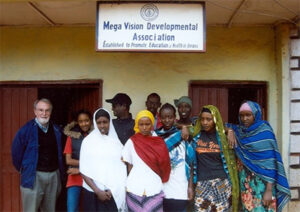
Dr. Torrey with Mega Vision Students
While all students in Borana are disadvantaged, girls are affected the most. Most of the girls who attend elementary level education dropped out of school before they reach middle school. While families would support a son going to high school, selling a cow to pay expenses, they would not help a daughter further her education.
Mega Vision supports girls through its educational material support and cash transfer for school attendance for university and college students. Today, more than 50 have graduated from university and colleges, and more than 50 are employed.
Mega Vision also supporting with textbooks and teacher guide books the first 100 students to attend the new high school. Built in 2009, the school in the village of Mega did not have teachers or books. Local people took on themselves to start school and not wait a year for teachers so their children did not have to travel to another town.
This small charitable organization also has been successful in achieving its ultimate goal of empowering women and promoting development in the area.
As Fuller wrote to me recently, “In late August 2011, Barbara and I site-visited the project we are sponsoring. This was my fourth visit to the Borana, one of the poorest and most remote areas of Ethiopia. Despite recently paved roads, it is still a 13-hour drive from Addis to the province.
“The school project just completed its sixth year and has two components. The primary component is the support of Borana girls to go to school. Girls are selected by a local committee based on academic promise and financial need. Borana families, most of whom are semi-nomadic cattle herders.”
Mega Vision pays for the girl’s school uniform, fees, books, and room and board with a local family for the school year in two Borana villages that have high schools.
Girls are selected from grades 5 and higher and remain in the program as long as their grades remain high. In 2010–11, there were 57 girls in the program. Altogether in the first six years, 124 girls have been supported, of which three have gone on to university, five others have gone on to vocational school.
There are currently 140 girls involved in the program. The summer program operated for approximately the first five years but was then phased out.
These four stories of continued connections to Ethiopia by former Volunteers and Staff can also be told by other Volunteers. Similar stories of involvement with their Peace Corps host countries are told by RPCVs in most of the 141 countries where the Peace Corps has served.
Fulfilling the Fourth Goal
What could not have been imagined by the founders of the Peace Corps is this Fourth Goal, the lasting connection PCVs have with their host countries. This connection has been expressed in scholarships provided, books donated, financial contributions made to in-country development projects, return trips to Peace Corps sites, and hundreds of personal memoirs.
Most of all, the Fourth Goal is the lasting friendships with strangers they would have never met if it wasn’t for the experience. They wanted to make a difference in the lives of others, only to find that they were ones most profoundly changed. They flew off into faraway counties and touched the world where it burns. And because they did, they have never healed.
John Coyne, co-founder (with Marian Haley Beil) of www.peacecorpsworldwide.org, both were Ethiopia 1962-64.
